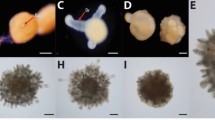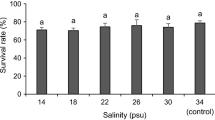Abstract
The combined effects of temperatures of 14, 17, 20, 22, and 25°C and salinities of 36–12‰ on embryos and larvae of the sand dollar Scaphechinus mirabilis was studied. Embryonic development is the most sensitive stage in the early ontogenesis of S. mirabilis. It is completed at a temperature of 14–20°C in a salinity range of 36–24‰ and at temperature of 22°C to 26‰. The fertilization proceeds in wider ranges of temperature and salinity. Among the swimming larvae, blastulae showed the greatest resistance to variations of these environmental factors. All the larvae survived at a temperature of 14–22°C and a salinity of 36–20‰, and more than 70% of them at 18‰. The pluteus I is the most vulnerable stage; probably this is related to the formation of the larval skeleton and transition to phytoplankton feeding. The survival of larvae at the age of 20 days was 100% at 14–22° C and a salinity of 36–24‰, most of them survived at 14–20°C and a salinity 18‰. The temperature 25 ° C is the most damaging for early development of S. mirabilis. The duration of development of that species lasts 28.5–29 days at 20°C and a salinity of 32.2–32.6‰. At 20 and 22°C, the larvae settled and completed metamorphosis more quickly if sand from the parental habitat was present. The larvae did not settle during the experiment (14 days) at 14 ° C and in the absence of sand.
Similar content being viewed by others
References
Artyukhov, A.A., Kupera, E.V., Rutskova, T.A., et al, Search of New Sources of Echinochrome for Production of Medicinal and Prophylactic Preparations. Issledovaniya v oblasti fiziko-khimicheskoi biologii i biotekhnologii: Materialy II Region. nauch. konf. 19–21 dekabrya 2006. Vladivostok (Researches in the Field of Physicochemical Biology and Biotechnology: Materials II Reg. Sci. Conf., December 19–21, 2006. Vladivostok,) p. 26.
Baranova, Z.I., Phylum Echinodermata, Zhivotnye i rasteniya zaliva Petra Velikogo (Animals and Plants of Peter the Great Bay), Leningrad: Nauka, 1976, pp. 114–120.
Bekova, N.V., Zhuravel, E.V., and Khristoforova, N.K., Effects of Desalination and the Detergent Sodium Dode-cylsulphate on the Early Development of the Sand Dollar Scaphechinus mirabilis, Biol. Morya, 2004, vol. 30, no. 3. pp. 208–214.
Brykov, V.A. and Kashenko, S.D., Distribution and Some Aspects of Ecology of Sand Dollars in the Vostok Bay, Sea of Japan, Biologicheskie issledovaniya zaliva Vostok, (Biological Researches in the Vostok Bay) Vladivostok: Dal. Vost. Nauch.Tsentr àN SSSR, 1976, pp. 143–150.
Dautov, S.Sh. and Kashenko, S.D., Development of the Sand Dollar Scaphechinus mirabilis, Biol. Morya, 2008, vol. 34, no. 6, pp. 456–461.
Dobretsov, N.L. Results of Activity of the Siberian Branch of the Russian Academy of Science in 2005 and Next Tasks in Modernization of Structure, Functions and Mechanisms of Financing of Academic Science in Siberia, Nauka v Sibiri, 2006, iss. 19 (2554).
Dyakonov, A.I., Echinoderms (Echinodermata) of Syahu Bay of the Sea of Japan Tr. gidrobiol. ekspeditsii ZIN AN SSSR, 1938, iss. 1, pp. 425–498.
Zhuravel, E.V., Markina, Z.V., Khristoforova. N.K., and Aizdaicher, N.A., Biotesting of Water Quality in Peter the Great Bay with the Use of the Microalga Dunaliella salina and Embryos and Larvae of the Sea Urchin Scaphechinus mirabilis, Biol. Morya, 2006, vol. 32, no. 3, pp. 188–196.
Kasyanov, V.L., Kryuchkova, G.A., Kulikova, V.A., and Medvedeva, L.A., Larvae of Sea Urchins (Morphology, Physiology, Behaviour), Lichinki morskikh dvustvorchatykh mollyuskov i iglokozhikh, (Larvae of Marine Bivalves and Echinoderms), Moscow: Nauka, 1983, pp. 108–154.
Kashenko, S.D., The Effect of Freshening on Development of Far East Trepang, Biol. Morya, 1992, no. 3–4, pp. 43–52.
Kashenko, S.D., Effects of Temperature and Salinity on the Early Development of the Japanese Sea Cucumber(Trepang) Stichopus japonicus, Biol. Morya, 1998, vol. 24, no. 2, pp. 103–107.
Kashenko, S.D., Combined Effect of Temperature and Salinity on the Development of the Holothurian Eupentacta fraudatrix, Biol. Morya, 2000, vol. 26, no. 3, pp. 182–187.
Kashenko, S.D., The Reaction of the Starfish Asterias amurensiss and Patiria pectinifera (Asteroidea) from Vostok Bay (Sea of Japan) to a Salinity Decrease, Biol. Morya, 2003, vol. 29, 2, pp. 127–131.
Kashenko, S.D., Responses of Embryos and Larvae of the Starfish Asterias amurensis to Changes in Temperature and Salinity, Biol. Morya, 2005, vol. 31, no. 5, pp. 344–351.
Kashenko, S.D., The Combined Effect of Temperature and Salinity on Development of the Sea Star Asterina pectinifera, Biol. Morya, 2006a, vol. 32, no. 1, pp. 43–49.
Kashenko, S.D., Resistance of the Heart Sea Urchin Echinocardium cordatum (Echinoidea: Spatangoida) to Extreme Environmental Changes, Biol. Morya, 2006b, vol. 32, no. 6, pp. 447–449.
Kashenko, S.D., Adaptive Responses of Embryos and Larvae of the Heart-Shaped Sea Urchin Echinocardium cordatum to Temperature and Salinity Changes, Biol. Morya, 2007, vol. 33, no. 6, pp. 423–431.
Kashenko, S.D., Responses of the Sand Dollar Scaphechinus mirabilis to Extreme Environmental Changes, Biol. Morya, 2008, vol. 34, no. 3, pp. 196–199.
Kryuchkova, G.A., Hybrid Larvae of Sand Dollars, Biol. Morya, 1977, no. 5, pp. 78–81.
Kryuchkova, G.A., Scaphechinus mirabilis (Agassis), Kratkii opredelitel’ lichinok morskikh ezhei, ofiur i goloturii zaliva Petra Velikogo Yaponskogo morya. Preprint No. 22 (The Brief Key to Larvae of Sand Dollars, Brittle Stars, and Holothuirians of the Peter the Great Bay, Sea of Japan. The Preprint 22), Vladivostok: Dal. Vost. Nauch. Tsentr AN SSSR, 1987, pp. 25–29.
Saranchova, O.L., Ontogenic Variations of Adaptive Response to Environomental Salinity in White Sea Asterias rubens L., Ekologicheskie issledovaniya donnykh organizmov Belogo morya (Ecological Research of Bottom Organisms of the White Sea), Leningrad: ZIN AN SSSR, 1986, pp. 42–49.
Saranchova, O.L., and Flyachinskaya, L.P., The Influence of Salinity on Early Ontogeny of the Mussel Mytilus edulis and the Starfish Asterias rubens from the White Sea, Biol. Morya, 2001, vol. 27, 2, pp. 110–116.
Urbach, V. Yu., Matematicheskaya statistika dlya biologov i medikov (Mathematical Statistics for Biologists and Physicians), Moscow: Izd. AN SSSR, 1963.
Bruce, B.D., Sutton, C.A., and Lyne, V., Laboratory and Field Studies of the Larval Distribution and Duration of the Introduced Seastar Asterias amurensis with Updated and Improved Prediction of the Species Spread Based on a Larval Dispersal Model, Final Report to Fisheries Research and Development Corporation, CSIRO, Australia, 1995.
Kominami, T. and Takata, H. Cellular Basis of Gastrulation in the Sand Dollar caphechinus mirabilis, Biol. Bull., 2000, vol. 199, no. 3, pp. 287–297.
Nisiyama, S., The Echinoid Fauna from Japan and Adjacent Regions. Part II, Palaeontol. Soc. JPN Spec. Pap., 1968, no. 13, pp. 112–122.
Roller, R.A. and Stickle, W.B., Effects of Salinity on Larval Tolerance and Early Developmental Rates of Four Species of Echinoderms, Can. J. Zool., 1985, vol. 63, pp. 1531–1538.
Author information
Authors and Affiliations
Corresponding author
Additional information
Original Russian Text © S.D. Kashenko, 2009, published in Biologiya Morya.
Rights and permissions
About this article
Cite this article
Kashenko, S.D. Effects of extreme changes of sea water temperature and salinity on the development of the sand dollar Scaphechinus mirabilis . Russ J Mar Biol 35, 422–430 (2009). https://doi.org/10.1134/S1063074009050083
Received:
Published:
Issue Date:
DOI: https://doi.org/10.1134/S1063074009050083




